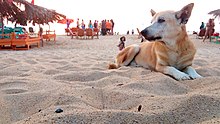Askal
| Askal | |||||||||||||||||||||||||||||||||
|---|---|---|---|---|---|---|---|---|---|---|---|---|---|---|---|---|---|---|---|---|---|---|---|---|---|---|---|---|---|---|---|---|---|
 A male askal on the beach | |||||||||||||||||||||||||||||||||
| Other names | Ayam, Irong Bisaya, Aspin | ||||||||||||||||||||||||||||||||
| Origin | Philippines | ||||||||||||||||||||||||||||||||
| Breed status | Not recognized as a breed by any major kennel club. | ||||||||||||||||||||||||||||||||
| |||||||||||||||||||||||||||||||||
| Dog (domestic dog) | |||||||||||||||||||||||||||||||||
Askal (asong kalye), means astray dogs, aspin or asong pinoy is the Tagalog language name for indigenous mixed-breed dogs in the Philippines.
Names[]
This section needs additional citations for verification. (February 2020) |

By the late 20th century, dogs commonly seen wandering the streets were called "askal", a Tagalog-derived portmanteau of asong kalye, which literally means street dog. In 2007, the Philippine Animal Welfare Society (PAWS) suggested the alternative term "aspin", short for asong Pinoy (Pinoy dog) to avoid the stigma associated with the term "askal".[1]
In Cebuano, dogs are called irong Bisaya, which literally means "Visayan dog" or "native dog",[a] implying that these are not thought of as a mixed-breed dog so much as unbred mongrels with no purebred ancestors.[2] This is only from a Visayan point of view since irong Bisaya does not differ in character or physical appearance from the other askals found in the Philippines. Physically, the dogs have "all shapes, configurations and sizes."[3]
Appearance[]
Aspins or Askals do not have clear lineages that contributed to what they look like today because they are bred from a diversity of mutts and mixed breeds that are roaming around Philippines streets. However, they have characteristics that distinctively identify them.[4]
The coat can be short haired or rough. Coat colors ranges from Black, Brown, White (commonly), Red (rare), Brindle, Gray, and Cream. Spots are commonly found at the base of the tail and at the back in semi-circular fashion. The snout sometimes appears black if the coat color is brown. The tail is usually held high and the ears can be floppy, semi-floppy or fully pointing upwards. The bone structure of a native Askal is on the medium range, never heavy like in Rottweilers.
Interactions with humans[]

Askals is the Filipino word for stray mixed-breed, indigenous dogs. There are over twelve million strays in the Philippines. Many consider it a problem because these dogs can go without much food or shelter their entire lives. The term "askals" can also refer to a domesticated, indigenous mixed-breed dog. They have been raised traditionally as guard dogs. They are naturally suspicious of strangers, independent and protective of family members. They are good to young children as companions, due to their devotion to family members. They are trusted by their owners to roam markets or the neighborhood to socialize with other dogs which is why some domesticated dogs are seen by the Western people as stray dogs when in fact they may not be. They are, however, expected to be home before dusk, especially males who always look for females in heat. Female dogs usually stay home and are excellent watch dogs. Askals were allowed to compete in the First Philippine Dog Agility Championships in 2013.[5][6] At the 2015 Pet Express Doggie Run in Pasay, askals were the featured dog.[7] The dogs featured in an essay by Gilda Cordero-Fernando.[8] Askals have been trained by the Coast Guard to identify bombs and drugs by scent.[9]
Notable askals[]
- Kabang, an askal who lost its snout while saving two young children[10][11]
- Buboy, waited of his owner who had already died several days before. However, Buboy died after being run over by a vehicle.[12]
- Boonrod (askal Dog), was found paddling near a rig 130 miles (220 kilometers) off the coast of Thailand.[13]
In popular culture[]
The Philippines national football team has been named as "the Azkals", an alternate spelling of "askal".[14]
See also[]
Notes[]
- ^ The use of the word "Bisaya" does not explicitly mean "Visayan" but it is a term pertaining to people and animals native to a specific locale. For example, "manok Bisaya" simply refers to a breed of chicken native to a locality.
References[]
- ^ Honasan, Alya (2007-07-22). "'Hey, pare, let's save the whales'". Philippine Daily Inquirer. Archived from the original on February 15, 2009. Retrieved 2007-10-25.
- ^ "Irong 'bisaya' magamit sa bomb sniffing". GMA News.TV. Retrieved 2007-10-07.
- ^ Alya B. Honasan (May 15, 2012). "In praise of the 'asong Pinoy'". Philippine Daily Inquirer. Retrieved 10 June 2015.
- ^ A Guide to Aspins, the Philippines’ Native Dogs
- ^ Jose Santino S. Bunachita (May 25, 2013). "askal to compete in national dog show". Philippine Daily Inquirer. Retrieved 10 June 2015.
- ^ Jujemay G. Awit (May 26, 2013). "From 5 cities, canines come to bow, wow in Philippine Dog Agility Association". Sun.Star. Archived from the original on 10 June 2015. Retrieved 10 June 2015.
- ^ Melissa G. Bagamasbad (March 17, 2015). "Pet Express Doggie Run 2015: 'askals' shine and get second chances at life". Retrieved 10 June 2015.
- ^ Ventura, Sylvia Mendez (2005). A Literary Journey with Gilda Cordero-Fernando. UP Press. pp. 94–. ISBN 978-971-542-483-7. Retrieved 10 June 2015.
- ^ Non Alquitran (January 27, 2015). "20 bomb-sniffing dogs from US to secure APEC meet". The Philippine Star. Retrieved 10 June 2015.
- ^ Campbell, Jeff> (2014-10-07). Daisy to the Rescue: True Stories of Daring Dogs, Paramedic Parrots, and Other Animal Heroes. Houghton Mifflin Harcourt. pp. 87–. ISBN 978-1-936976-62-1. Retrieved 10 June 2015.
- ^ "PHL's hero dog Kabang soon to undergo $20,000 facial surgery in US". GMA News Online. 2012-10-09. Retrieved 18 August 2016.
- ^ "Viral dog Buboy gone soon after master's death (June 2019)".
- ^ "Dog found swimming 130 miles off the coast of Thailand (April 2019)". CNN.
- ^ Lao, Edward. "Philippine United: First Pinoy soccer team in UK". ABS-CBN News. Retrieved 2019-12-08.
- Dog types
- Dog breeds originating in the Philippines
- Animal breeds originating in the Philippines
- Mixed-breed dogs
- Mammals of the Philippines
- Philippine culture
- Street dogs
- Tagalog words and phrases